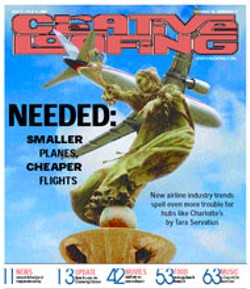Needed: Smaller Planes, Cheaper Flights
New airline industry trends spell even more trouble for hubs like Charlotte’s
What are these changes? Put simply, there are now small jet airplanes with incredible range that can fly from coast to coast. In the past, smaller jets serving smaller airports couldn't make it so far without stopping to refuel.
This technology has been around for at least five years, in some cases longer. But the difference now is that discount and smaller airlines, and in some cases major airlines are stockpiling hundreds of these planes and flying them out of locations once served by hubs. The result? Flights to the hubs from outlying cities are being choked off.
US Airways' competitors are doing this by offering cheaper flights on smaller planes that fly directly to a destination rather than stopping over at a hub to pick up more passengers. These discount service carriers, which made up six to seven percent of the market a decade ago, now dominate 20 percent of the market, says aviation consultant Robert Mark. This means that these discount service carriers now have enough power to compete with the bigger airlines and force a change in the market.
While financially frustrated US Airways execs sit back and watch, airlines like Jet Blue or Southwest, the only major airline to make a profit last year, are buying and running hundreds of smaller, long-range jets like Boeing 737s and Airbus A319s coast to coast and between smaller regional airports. In the past, the hubs sucked in a hefty share of this traffic.
Fifteen years ago, when Charlotte-Douglas become a hub airport, the logic was that you might not get hundreds of people flying to Charlotte from a mid-sized Midwestern city every day, but since the Charlotte hub offered hundreds of destinations -- aside from Charlotte -- you could fill the planes flying out of Charlotte with people from dozens of Midwestern cities. Each flight into a hub like Charlotte's could have exponential impact because folks flying in from all over could be added to it before it took off again, which filled large and small airplanes alike.
But if smaller, more efficient airlines offer flights out of, say, Oklahoma City on 50-to 70-seat jets with no stops, no meals, no movies and fares in some cases half those of the big airlines, those Oklahoma passengers have a more attractive choice they didn't have before. They wind up on a smaller jet that gets them to their destination two hours earlier than they would have had they sat around waiting at a hub. And somewhere, at a hub, a plane that could have been filled with connecting passengers from Oklahoma takes off half empty.
Since it purchased long-range Boeing 737-700s in 1997, Southwest Airlines, currently famed around the country for its short-flight regional service on small jets, has given larger airlines the jitters by introducing longer point-to-point flights that have pulled incoming flights away from the hubs, a phenomenon called "bleed off."
Can US Airways compete?The Washington Post reported with a fair amount of fanfare that starting in September, Southwest Airlines would be offering flights between Baltimore-Washington International Airport and Los Angeles, the first transcontinental flight for the short-range airline. Southwest's introductory fare for flights between BWI and Los Angeles? Only $200 round trip with a seven-day advance ticket purchase, the lowest fare in the industry. Given that the average round trip fare between BWI and Los Angeles is $420, it's not surprising that US Airways plans to eliminate its daily nonstop flights between BWI and Los Angeles in September.
"As we speak, there is bleed off from US Airways where Southwest flies," says US Airways spokesman David Castelveter. "It's really too early to determine what if any effect more point-to-point flights (by other airlines) will have on US Airways. We have been faced with competition with Southwest, AirTran Airways and Jet Blue and based on our company's exiting cost structure we have not been able to compete effectively."
Jerry Orr, Charlotte-Douglas International Airport's aviation director, says that one of US Airways' problems is that it hasn't gotten into the regional jet market like it should have.
That's partly due, he says, to the airline's current financial position and to a contractual agreement with its pilots that up until two months ago only allowed the airline to run a total of 70 regional or smaller-sized jets across its entire system. To pilots, who are paid according to the size of the planes they fly, the regional jets and smaller jets being used on cross-country point-to-point flights by US Airways' competitors are seen as a threat. They see US Airways' efforts to run smaller planes along routes formerly serviced by large planes as an effort to undercut them by replacing them with lower-cost crews on smaller planes. But, says US Airways' Castelveter, the airline must fly hundreds more regional jets that hold 50 to 90 passengers just to compete in the changing market.
And while the airline and its pilots recently renegotiated the number of regional jets it can fly from 70 jets to 140, both Castelveter and Orr say that US Airways needs to fly 300 to 500 jets of that size in order to compete successfully in this new, changing market.
"Our competitors are flying hundreds of regional jets and literally poaching off us," said Castelveter. "Because we have such a competitive disadvantage on the regional jet front, we can't compete effectively."
Although Castelveter says the airline hopes to eventually cut a deal with its pilots that will allow it to run at least 300 regional jets, he says that that's not likely to happen in the immediate future.
"There is nothing worse than watching the competitive atmosphere change drastically at a time when your checkbook is pretty low and you can't do anything about it," says aviation consultant Robert Mark. "US Airways is saying "Do we do what they are doing or do we let them go and see what happens?'"
What does it mean?What will likely happen, experts say, is that the smaller carriers will revolutionize the industry, or at least a significant part of the industry, with smaller fares and no-frills direct flights that business flyers now demand.
So what does it all mean for Charlotte's hub? National experts disagree on the answer to that question. Some predicted dire consequences for our hub. Others weren't so sure.
Airline consultant Morten Beyer of Morten Beyer & Agnew says the new changes in the industry will have more of an impact on Charlotte's hub than they will on Atlanta's.
"There is a certain amount of artificiality to the Charlotte hub," said Beyer. "Charlotte is not a dominating city in the way an Atlanta or Chicago or Denver is. In the Southeast there are other cities of roughly equivalent or greater status. US Airways has made it into a hub of greater significance than is warranted by Charlotte's economic status in the region."
Beyer predicts that the size of Charlotte's hub will eventually be brought more in line with what it should be in relation to its economy.
"I could see in the future if US Airways should be acquired by another carrier, its successor might not continue to build the Charlotte hub or would overfly it without going through Charlotte," says Beyer.
Others, like Alan Bender, an airline economist with Embry-Riddle Aeronautical University in Florida, say there will always be a need for a hub and spoke system like the one US Airways operates in Charlotte, but he thinks the hub system in this country, and particularly in Charlotte, is overbuilt.
"Hubs have been around forever," said Bender. "I believe the Charlotte hub will survive, I just don't know whether it will survive in the magnitude it was built up to."
George Mason University Public Policy Professor Kenneth Button agrees that the changing nature of competition in the industry will hit some of the hubs and bleed traffic from them, but he thinks its impact will be much greater upon the larger hubs than on the smaller ones like Charlotte's. In fact, he says, Charlotte's hub could benefit.
"The really big hubs are going to lose some traffic to medium-size hubs," said Button. "These can operate viably with a smaller number of passengers. It could be that some secondary carrier comes in and serves your banks. These cross-continental flights could help the medium-size airports."
Castelveter, the US Airways spokesman, says the company realizes it will have to compete effectively from the spokes in the hubs so it can fill planes to longer-haul destinations. He says the company has a three-point plan of attack. He says the airline is trying to form alliances with a larger network of other carriers to provide lower-cost service, to lower operating costs by over $1 billion a year, and to negotiate with its pilots and crews.
Orr, who has seen Charlotte's hub through thick and thin, acknowledges that point-to-point flights -- of which Charlotte's hub already has many -- are clearly the most efficient way to serve two destinations assuming there's a sufficient number of travelers in those markets to warrant service. But, he points out, Southwest Airlines only serves 58 cities, so it can pick the pairs of destinations it wants based on sufficient travel to fill its airplanes.
Translation: Southwest's success in those cities can't necessarily be duplicated at the other approximately 400 airports across the country it doesn't serve because market conditions and the number of available travelers to board planes differ, leaving plenty of room for the hub system and the stopovers needed to fill planes.
"If it weren't for hubs, places like Florence, SC, wouldn't have service," said Orr.
Latest in Cover
Calendar
-

Wine & Paint @ Blackfinn Ameripub- Ballantyne
-

Face to Face Foundation Gala @ The Revelry North End
-
An Evening With Phil Rosenthal Of "Somebody Feed Phil" @ Knight Theater
-
Kountry Wayne: The King Of Hearts Tour @ Ovens Auditorium
-

Queen Charlotte Fair @ Route 29 Pavilion
-
Canuck in the Queen City 7
A Canadian transplant looks back at her first year as a Charlotte resident
-
Homer's night on the town 41
If you drank a shot with the Knights mascot on Sept. 20, you were basically harboring a fugitive
-
Delic Holdings Inc. Announces Meet DELIC, the Premiere Psychedelic and Wellness Edutainment Event and Expo for Newcomers and Veteran Psychonauts, Announces Initial Speaker Lineup 42












